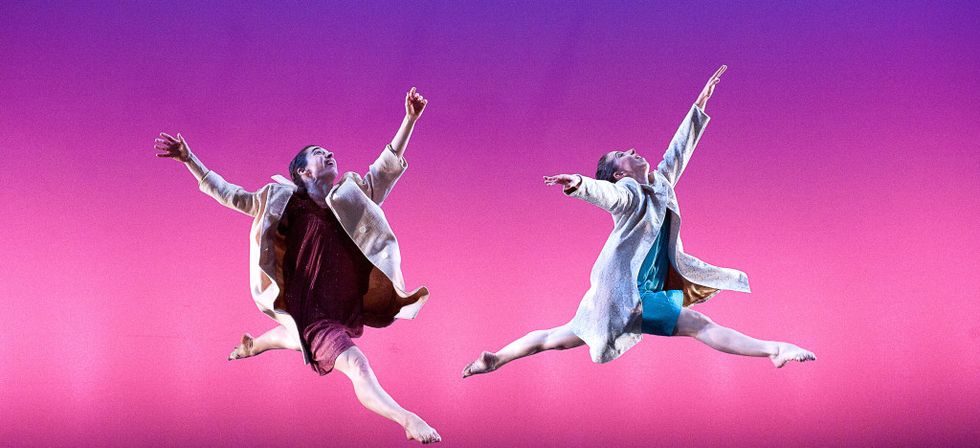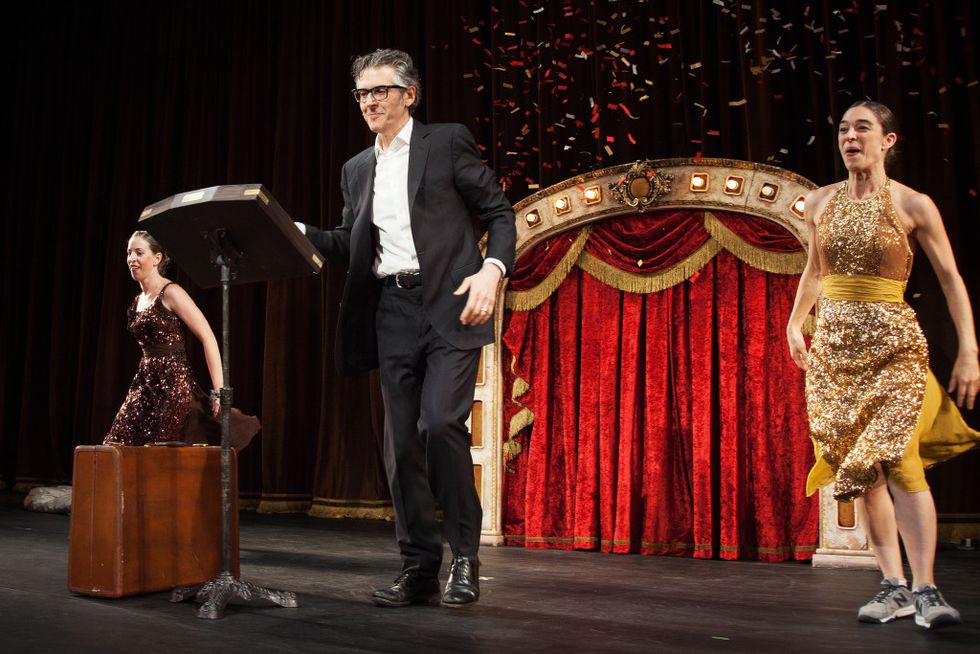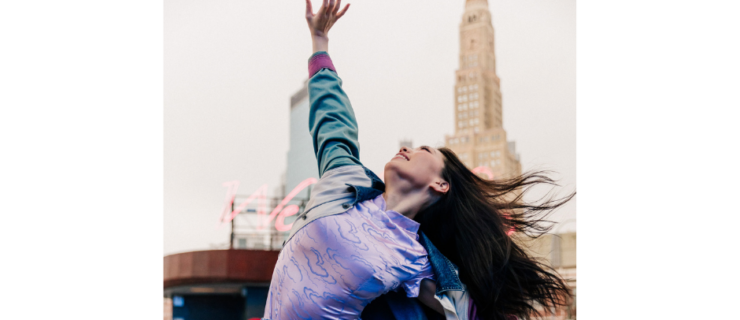The Humor and Hustle of Monica Bill Barnes
In sequined dresses and tennis shoes, Monica Bill Barnes and Anna Bass march up to the statue of Perseus with the Head of Medusa, and start doing jumping jacks to the sounds of ’70s music. From there, they lead a small cohort through a French Renaissance gallery of the Metropolitan Museum of Art, then to an Italian Renaissance gallery for stretching, then to the American wing for squats. They are testing out possibilities for a new concept: The Museum Workout, which the Met Museum will present in its 2016–17 season. It’s not a dance, per se, but it’s movement as a means to connection. And in the past few years, that philosophy has taken this adventurous pair to some pretty unexpected places.
One such place was a live episode of the popular radio program This American Life. As a follow-up, Ira Glass, the program’s famous host, offered to moderate post-show talks at performances of Monica Bill Barnes & Company. Barnes countered with a proposal to integrate him into a show instead. The result was Three Acts, Two Dancers, One Radio Host, a delightfully poignant evening of storytelling and dance that wasn’t meant to last more than a few performances. But nearly three years later, the trio is still touring it across the country with dates booked through this summer. “It’s been so much more than we ever thought it would be,” Barnes says.

Barnes and her artistic partner Anna Bass share a similar awkward charm. Photo by Adrianne Mathiowetz.
Most small dance companies are lucky for the occasional chance to show their work to intimate audiences out of town. But the popularity of Three Acts has exposed tens of thousands of viewers to Barnes’ singular blend of vaudeville, variety show, slapstick and showmanship. “A large part of my mission is to bring in audiences who aren’t as familiar with dance,” she says, which is one reason the collaboration with Glass was such a good fit. From the beginning, Barnes has been intentional about the impact she wants to make, and tenacious about creating a business model that allows dance to be not just a lifestyle but a living.
After completing her MFA at New York University in 1997, Barnes started a “company” (her air quotes), which basically meant “making solos for anyone who would watch.” Her goal was to sustain herself financially entirely through dance, which she managed to do after only two years, with “a combo of the most ridiculous work you could imagine.” If she got a teaching gig in Virginia, she’d call schools in a 300-mile radius to offer master classes and performances. If a school three hours away accepted, she’d spend her entire fee on gas to get there. In other words, she hustled.
She danced for other artists, like Guta Hedewig and Allyson Green, and started making duets and quartets. For a long time, she got asked “Is the company ever going to get bigger?” as if an increase in size would indicate an increase in seriousness. “It’s intentionally smaller,” she says, noting that she has always believed in paying her dancers fairly. “Partially for finances but also because I think you identify more. In a smaller group you can see individuals better.”

Photo by Christopher Duggan, Courtesy Barnes.
In recent years, the individual that cannot be missed is Bass, who started working with Barnes in 2003 and is now her associate artistic director. “We discovered that our physicality and instinct and impulses are so similar,” Bass says. They share an uncanny sense of charmingly awkward swagger. Onstage, they portray characters—overeager hosts, cocky high-rollers or corporate businessmen out for a good time, as in their most recent show, Happy Hour, a weekly after-work performance complete with cocktails, karaoke and a raffle. It’s fun, and funny. Humor, perhaps more than anything else, is Barnes’ signature. But dance audiences aren’t generally primed to laugh, so to let them know it’s okay, Barnes and Bass borrow a trick from comedians like Louis C.K. and Bill Burr.
“Comedians tend to present themselves with a lot of self-deprecation,” Barnes says. If they do it well and with confidence, it’s a joy to laugh at them. “You can’t laugh at somebody that you’re worried about,” she adds, explaining, “We give the audience permission to laugh at us because beneath it all, they know that we’re fine.” As in comedy, the humor is the real-time feedback that lets you know you’ve hooked an audience: When you hear the laughter, Barnes says, “you know they understood.”
Audience enjoyment is the raison d’être of the company. “For me the purpose of making a show is to connect with an audience,” says Barnes. “And if the show fails to connect…that’s our fault.” Unlike some choreographers for whom steps are sacred, with Barnes, the moves come second. “She privileges the experience over everything,” observes Robert Saenz de Viteri, who joined the company to help manage Three Acts and stayed on in a role created for him as creative producing director. “The choreography is just material.”

Photo by Mallory Lynn, Courtesy Barnes.
Yet that connection takes different shapes when the duo performs Three Acts one night in a 3,000-seat hall and Happy Hour a few days later for a small audience in a room that fits 70. The dramatic shift is by design. “There is a really strategic eye on not being redundant,” says Barnes. The obvious choice after Three Acts, given its reception and box office receipts, would have been to capitalize on the concept and launch version 2.0. Happy Hour, in many ways, is counterintuitive. But it has led to exciting new partnerships, such as with the Ace Hotel, which presented Three Acts in Los Angeles in the fall and is now discussing bringing Happy Hour to some of its properties.
“Partnering with the Ace is really asking us to think about the show in a different way,” says Barnes. They’ve brainstormed with hotel executives about venues, audiences and even ticket prices. She loves working with a business because it looks at dance differently—just as Barnes has done from the beginning.
Part of her longevity comes from operating like a business herself (though the company is a nonprofit). Barnes, Bass and Saenz de Viteri all draw full-time salaries; Kelly Hanson, their costume and set designer, and Jane Cox, their lighting designer, are part-time contractors, and all of them receive annual raises. With the help of Three Acts, the company now has a savings account, which “just lets you sleep better at night,” says Barnes.
But this financial security only comes from being unafraid to take big risks, and by being patient enough to give quirky ideas generous gestation periods. The impending museum workout, two years in the making, is another such gamble, but one that has already earned the enthusiasm of curators. “The museum hasn’t done anything like this before,” says Juliana Dweck, of the Princeton University Art Museum, where much of the piece was developed. “To Anna and Monica, everything is an experiment. They’re working outside any boxes.”
Joining forces with radio hosts, hotel chains and museums isn’t so different from cold-calling a university 300 miles away—it comes from the same “anything goes” and “make it work” attitude. Nearly two decades later, Monica Bill Barnes is still hustling, just on a much larger scale.




